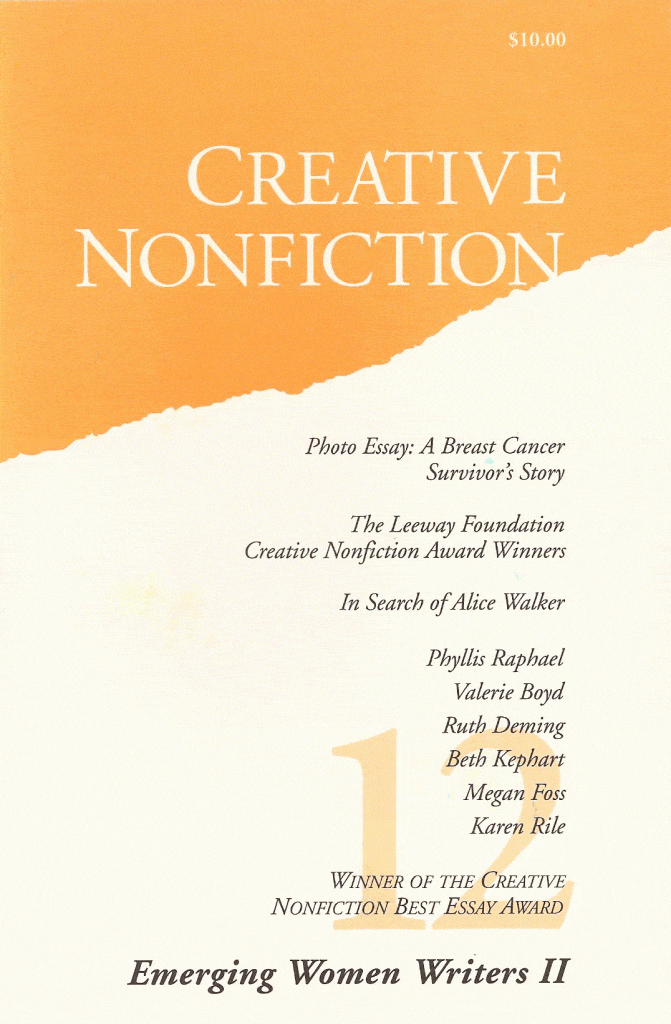Issue 12 / 1999

12 / Emerging Women Writers II
This issue features work by emerging women writers who tell compelling and intricately detailed stories while being incisive, reflective and deeply personal. This issue begins with the winner of a creative nonfiction best essay award, “Post Mortem,” Norma V.L. Clarke’s essay about the torture of attending medical school in Jamaica and the riveting hold on her life by her mother. The three semifinalists, also included in this issue, were: “The Old Sort: Of Connemaras & Sweet Corn” by Caroline Nesbitt, “Dreamland” by Kathryn Hoffman Hughes and “Reunion” by Leaf Seligman.
Already a subscriber?
Read this issue nowTable of Contents
FROM THE EDITOR: Spontaneous Connections: Emerging Women Writers—Again
I believe in the power of spontaneous connections. One of our most popular issues, Emerging Women Writers, published in 1995, sold out almost immediately. So far, four of the seven essays which anchored that issue have become books by authors Lauren Slater, Jeanne Marie Laskas, Kathryn Rhett and Diana Hume George.Post Mortem
I entered medical school at the University of the West Indies one year out of high school, when I was 19 years old. My life up to that point had been relentlessly dedicated to getting accepted to medical school; it has always surprised me that my medical school years were among the worst of my life.Waiting for the Red Baron
Jeremy and I, we’re playing planes. It’s his new favorite game, after all. “See?” he tells me. He spreads his arms out wide on either side, crooks his elbows, presses into flight.The Old Sort: Of Connemaras & Sweet Corn
My back pasture was graced for a short time by a blue roan mare called Maeve. She was rescued from still another field by her present owners, the largely forgotten result of an ill-funded pony breeding operation whose proprietor’s interest evaporated when it became apparent that pony breeding did not lead to instant fortune.Dreamland
The day after graduation she packs up her nursing degree and single suitcase, a reluctant gift from Fritz and Rose, watching their first leave the farm.Recollecting
“So, just how big was the knife?” she asked me, sometime during our second interview. “Was it this long?” She held her thin, manicured hands six inches apart. “No. Longer,” I said and shook my head slightly.Afternoon At The Whitney
A man and a woman on the telephone, he in Los Angeles in a film production office in Beverly Hills, she in New York in an apartment on the West Side.Stephanie
This is me. This image tells a lot about me, but what it doesn’t say is that I’ve had cancer. Just after I turned 30 years old, my right breast began to feel painful and swollen. I couldn’t feel a lump.Back to the Future
I often—while soaking in a hot bath—orchestrate a fantasy of visiting with my younger self. These tête-à-têtes degenerate quickly into lectures. After a perfunctory inventory of the indignities that seven years of childbearing have inflicted on my present body, we move on to a more cerebral plane.Reunion
Why are you going? friends ask. Because I must, I answer.The Monster Between Us
It is much easier to point to the exact moment of her birth than it has been to realize the moment of her conception. That moment that is the last secret I’ve held to.A Sunny Day at the SPCA
From the start, when the dog first arrived, small, white and shaking, he would sit by the stairs and wait for my father to come home. When he heard the car pull in, he would dash down the stairs with high-pitched squeals, half-tumbling, half-falling, until, with calm expectation, he would face the door and wait for my father to appear.In Search of Alice Walker, or, Alice Doesn’t Live Here Anymore
Alice Walker hasn’t arrived yet. On this warm, wet October evening, a patchwork quilt of people is gathering at the Crowne Plaza Hotel in Macon, Georgia. The mayor is here, along with several members of the City Council.About the Author: Floyd Skloot
“I believe that if I can write about living with brain damage well enough to communicate what it’s like, to discover what it means and how it plays out in a person’s life, then I will also be able to understand it well enough to live with it, make an honest life that incorporates it, and make it clear for others.”About the Author: Kathryn Hoffman Hughes
Kathryn Hoffman Hughes uses the hazy memory of second person to recount her childhood in “Dreamland.”About the Author: Megan Foss
“When I sit down to work on a chapter or an essay there are two things I start out knowing,” Megan Foss, the author of “The Monster Between Us,” says.About the Author: Norma V. L. Clarke
Norma Clarke always wanted to write. But life took her on a whirlwind before she knew it was time to begin.About the Author: Beth Kephart
Beth Kephart never intended for "Waiting for the Red Baron" and the other stories in her book, "A Slant of Sun: One Child's Courage," to appear in print.About the Author: Carolyn Nesbitt
When Carolyn Nesbitt began writing essays, it was an attempt to make sense out of a lot of disparate ideas. "I've always been interested in huge numbers of things, most of which bear no resemblance to each other."About the Author: Leaf Seligman
Leaf Seligman understands the value in rewrites. “When I first came home and started to write about the reunion, it came out so flat and so boring. It was just awful,” she says.About the Author: Debra Ann Davis
When Debra Davis began writing “Recollecting,” she intended the essay to be about her interview with the District Attorney. The essay turned out to be about memory.About the Author: Ruth Deming
Ruth Deming’s “A Sunny Day at the SPCA” portrays a delicate interplay of familial emotion, both expressed and unexpressed, through the somewhat more accessible vehicle of the family dog, Triscuit.
